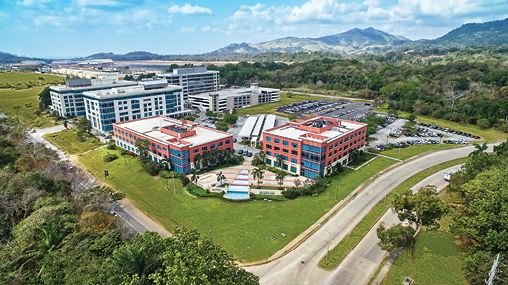As global and Americas trends point toward more reshoring, nearshoring and friend-shoring in an industry boosted by the rocket fuel of the U.S. federal government’s CHIPS and Science Act, important semiconductor operations may find Panama a newly attractive alternative in the very near future.
The “World Fab Forecast” released by SEMI in January predicted that semiconductor capacity is expected to increase 6.4% in 2024 to top the 30 million wafers per month (wpm) mark for the first time. China and Taiwan lead the way by a long shot with 8.6 million wpm and 5.7 million wpm, respectively. Which is why the U.S. — projected to ”increase to 3.1 million wpm in 2024 with six new fabs” — is pursuing a moonshot of sorts to catch up.
Part of that federal support is the International Technology Security and Innovation (ITSI) Fund created by the CHIPS Act, which provides the U.S. Department of State with $100 million per year over five years to “expand global semiconductor manufacturing; secure semiconductor supply chains; and develop and deploy secure and trustworthy information and communications technology networks and services through new programs and initiatives with our allies and partners.”
The State Department in July 2023 confirmed it would partner with Panama under ITSI. The new direction — focused on the country’s potential as a hub for semiconductor assembly, packaging, and testing (AT&P), Outsourced Semiconductor Assembly and Test (OSAT) and other value-add services — builds on the country’s strengths in logistics and digital services; the transport and utility infrastructure undergirding its well-developed energy and tourism sectors; and Panama’s political stability.
“Panama is a place for development of connections,” says PROPANAMA General Administrator Carmen Gisela Vergara Mas. “This is an industry that has so much potential for growth, from over $575 billion in value in 2022 to around $1.3 trillion globally by 2029.”
The AT&P niche alone was valued at around $33.8 billion in 2022 and is projected to grow to around $57.4 billion by 2032.

Free zone assets such as Colon Free Trade Zone and the 6,177-acre Panama Pacifico (pictured) located at the former U.S. Air Force base just outside Panama City offer just-in-time capabilities for potential semiconductor assembly, test and packaging operations.
”The United States is largely lacking a supply chain to support assembly, test and package activities.”
— U.S. Department of Commerce report, December 2023
Partners and Skills Required
Review of Panama’s current semiconductor ecosystem, regulatory framework, and workforce and infrastructure needs is ongoing. But the focus of Panama is on the same type of incremental, generational investment made by global players such as Intel in Costa Rica just to the north — specifically in the realm of AT&P operations. Costa Rica is one of several other countries also named as partners under the ITSI Fund program, the others being Indonesia, the Philippines and Vietnam.
Among the conclusions in a 107-page report released in December 2023 by the U.S. Department of Commerce Bureau of Industry and Security (BIS) Office of Technology Evaluation was this: “The United States is largely lacking a supply chain to support assembly, test, and package (AT&P) activities.” Near-shore capabilities figure to help wean the U.S. from overdependence on operations in faraway Asia.
The country already fits the profile of a place proficient in logistics and value-add processes in general, buttressed by the presence of special areas such as the Colon Free Trade Zone and the 6,177-acre Panama Pacifico Free Trade Zone, where industry can not only deliver and dispatch product, but transform that product and ship it out in the space of a day.
Panama has entered into talks with Arizona State University, a well-known contributor of talent and R&D to the booming semiconductor industry in the Greater Phoenix area. The collaboration with Arizona State includes a dedicated task force, collaboration on academic program development and the potential development of a center for semiconductors at the Technical University of Panama complete with labs and training facilities.
PROPANAMA Investment Unit Manager Stephanie Pragnell says Panama’s talent profile lends itself to such occupations as plant management, refrigeration, clean rooms, process management and mechanical engineering, among others. “We have a good turnout of industrial engineers,” she says, noting 265 graduates in that profession from the Technical University of Panama alone in 2022.
Meanwhile, says Vergara, “We hope to be working with our neighbor Costa Rica,” where it’s a known fact that the country is also struggling to increase the number of trained personnel to “maximize their enjoyment of this opportunity,” she says. “I think there is room for collaboration there.”
Working with Costa Rica on the creation of a more resilient semiconductor ecosystem “is better for the region and puts us in the technological spotlight,” she says. “There are strengths we both have that are complementary. In Panama, it will still take some years to have that system in place. But since we’re next to each other, it’s a win-win. It is a huge industry. There is space for everybody. If we play to our strengths and collaborate, I think we can build a very strong semiconductor ecosystem.”
This Investment Profile was produced under the auspices of PROPANAMA, the National Authority for Investment and Exports Promotion of the Republic of Panama. For more information, visit propanama.gob.pa.

